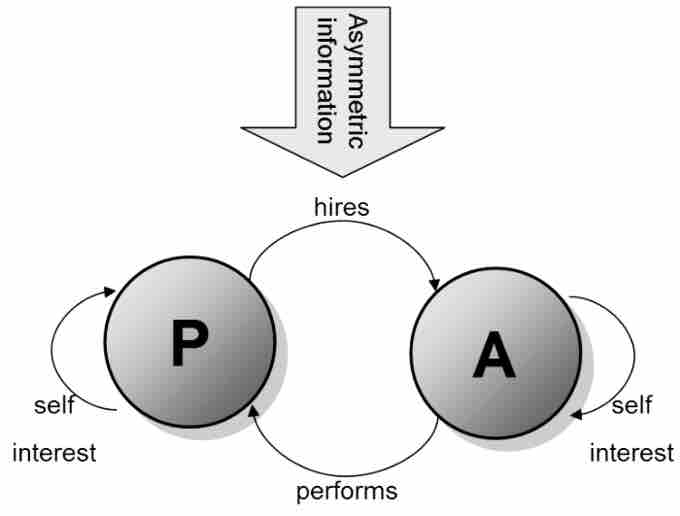Principal-Agent Problem
In economics, the principal-agent problem (also known as an agency dilemma) exists when conflicts of interest arise between a principal and an agent in a business setting . Conflicts usually exist when contracts are written due to uncertainty and risk taken on by both parties. The principal hires the agent to perform specific to duties that represent its best interest. The work that is performed can be costly to the agent and not in the principal's best interest. In short, the work done by the agent doesn't actually reflect the best interests of the principal. Examples of relationships that can experience the principal-agent problem include:

Principle agent problem
The diagram shows the basic idea of the principle agent problem. P is the principle and A is the agent. It clearly illustrates the working relationship between the principle and the agent while highlighting the presence of business partnership as well as self-interest.
- Management (agent) and shareholders (principal)
- Politicians (agent) and voters (principal)
The conflict of interest potentially arises in almost any context where one party is being paid by another to do something, whether it is in formal employment or a negotiated deal. The two parties have different interests and asymmetric information. The deviation of the agent from the principals interest is referred to as "agency costs. "
Contract Design
In order to minimize and control economic conflict, principals and agents design and agree on a contract. It serves as a guide and agreement to safeguard the best interests of both parties. The linear model is used to determine incentive compensation in a contract: w = a + b(e + x + gy).
In the linear model w is the wage, a is a constant, e is the unobserved effort, x is the unobserved exogenous effects on outcomes, and y is the observed exogenous effects; while g and a represent the weight given to y, and the base salary.
A business contract creates a straightforward connection between agent performance and profitability. This connection sets the standard for judging the performance of the agent.
Performance Evaluation
In business relationships, the principal will use performance evaluations to ensure that the agent is fulfilling the necessary duties. There are two forms of performance evaluation:
- objective performance evaluation - takes into account how fast a task can be completed. The evaluation compares the performance of an agent by comparing the work completed by peers within the industry.
- subjective performance evaluation - involves the principal directly evaluating the performance of the agent. In this case, the evaluation is based on opinions instead of observations or reasoning. .
Incentive Structures
Incentive structures are used in business relationship in order to bridge the gap between best interests of the principal and the agent.
Principals offer various incentive structures, which are rewards or motivating factors that drive the agent to work in the best interest of the principal and complete tasks efficiently. Incentive structures include price rates/commissions, profit sharing, and efficiency wages.
It is usually in best interest of both parties to work together. For the principal, agent inefficiency results in sub-optimal results and low welfare. For the agent, efficiency is important in order to receive payment for work completed.